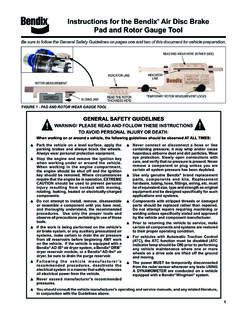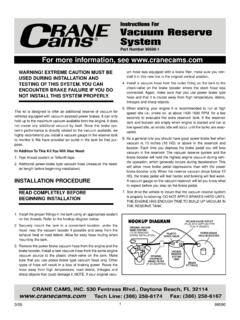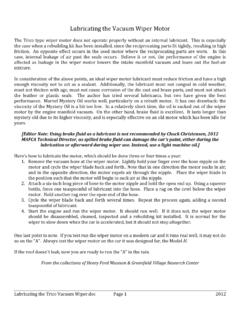Transcription of Maintenance Manual MM-0467 DiscPlus™ EX225 Air Disc Brake
1 Maintenance Manual MM-0467 DiscPlus EX225 Air Disc BrakeRevised 02-13 Service NotesInformation contained in this publication was in effect at the time the publication was approved for printing and is subject to change without notice or liability. Meritor Heavy Vehicle Systems, LLC, reserves the right to revise the information presented or to discontinue the production of parts described at any Maintenance Manual MM-0467 (Revised 02-13)About This ManualThis Manual provides installation and Maintenance procedures for the DiscPlus EX225 air disc You and understand all instructions and procedures before you begin to service and observe all Warning and Caution hazard alert messages in this publication. They provide information that can help prevent serious personal injury, damage to components, or your company s Maintenance and service, installation, and diagnostics special tools when required to help avoid serious personal injury and damage to Alert Messages and Torque SymbolsWARNINGA Warning alerts you to an instruction or procedure that you must follow exactly to avoid serious personal injury and damage to Caution alerts you to an instruction or procedure that you must follow exactly to avoid damage to components.
2 @ This symbol alerts you to tighten fasteners to a specified torque to Obtain Additional Maintenance and Service InformationVisit Literature on Demand on to access and order additional the OnTrac Customer Service Center at 866-668-7221 (United States and Canada); 001-800-889-1834 (Mexico): or email Tools and Supplies are Specified in This ManualContact Meritor s Commercial Vehicle Aftermarket and Non-Asbestos Fibers1 Section 1: Exploded ViewsDiscPlus EX225 Air Disc Brake2 Hub and Rotor Assembly3 Caliper Sectional View4 Adjuster Sectional View5 Section 2: IntroductionDescriptionOperationAutomati c AdjustmentOperation Without Adjustment6 Operation with AdjustmentManual Adjustment and Deadjustment During a Pad Change7 Section 3: Roadside InspectionIntervalsProceduresInspection ProcedureCaliper AdjustmentLining Wear8 RotorAir Chamber9 Section 4.
3 Caliper Assembly and Brake PadInspectionCaliperBrake Deadjustment Procedure10 Brake Adjustment InspectionBrake Pad Removal and Inspection13 Check Slide Pin Bushing Wear14 Brake Pad Installation16 Set the Initial Brake Pad-to-Rotor Running Clearance17 Section 5: Caliper Components ReplacementIntroductionRemove the Caliper Assembly18 Install the Caliper Assembly19 Replace the Adjuster CoverReplace the Piston Boots22 Remove the Caliper Bridge23 Remove the Caliper Housing AssemblyRemove the Slide Pin Boots24 Remove the Slide Pin Bushings26 Install the Slide Pin Bushings28 Replace the Slide Pins29 Install the Slide Pin BootsInstall the Caliper Housing Assembly31 Install the Caliper Bridge33 Section 6: RotorInspectionCracksHeat Checking34 Light Heat CheckingHeavy Heat CheckingDeep Grooves or ScoresBlue Marks or Bands35 Measure the Rotor ThicknessMeasure the Rotor Runout36 Removal and InstallationReplace the Rotor37 Section 7: Air ChamberIntroductionInspection38 InstallationSpring or Service Brake Chamber40 Section 8: SpecificationsLining Wear LimitsTorque Specifications42 Section 9: DiagnosticsTroubleshooting44 Section 10: Special ToolsMST 1000, Bushing Service Tool45 MST225 5001, ADB225 Wrench (Extension Adapter)Asbestos and Non-Asbestos FibersiMeritor Maintenance Manual MM-0467 (Revised 02-13)Figure ASBESTOS FIBERS WARNING The following procedures for servicing brakes are recommended to reduce exposure to asbestos fiber dust, a cancer and lung disease hazard.
4 Material Safety Data Sheets are available from Meritor. Hazard SummaryBecause some Brake linings contain asbestos, workers who service brakes must understand the potential hazards of asbestos and precautions for reducing risks. Exposure to airborne asbestos dust can cause serious and possibly fatal diseases, including asbestosis (a chronic lung disease) and cancer, principally lung cancer and mesothelioma (a cancer of the lining of the chest or abdominal cavities). Some studies show that the risk of lung cancer among persons who smoke and who are exposed to asbestos is much greater than the risk for non-smokers. Symptoms of these diseases may not become apparent for 15, 20 or more years after the first exposure to , workers must use caution to avoid creating and breathing dust when servicing brakes. Specific recommended work practices for reducing exposure to asbestos dust follow.
5 Consult your employer for more Work Practices1. Separate Work Areas. Whenever feasible, service brakes in a separate area away from other operations to reduce risks to unprotected persons. OSHA has set a maximum allowable level of exposure for asbestos of f/cc as an 8-hour time-weighted average and f/cc averaged over a 30-minute period. Scientists disagree, however, to what extent adherence to the maximum allowable exposure levels will eliminate the risk of disease that can result from inhaling asbestos dust. OSHA requires that the following sign be posted at the entrance to areas where exposures exceed either of the maximum allowable levels:DANGER: ASBESTOSCANCER AND LUNG DISEASE HAZARDAUTHORIZED PERSONNEL ONLYRESPIRATORS AND PROTECTIVE CLOTHINGARE REQUIRED IN THIS AREA. 2. Respiratory Protection. Wear a respirator equipped with a high-efficiency (HEPA) filter approved by NIOSH or MSHA for use with asbestos at all times when servicing brakes, beginning with the removal of the Procedures for Servicing Enclose the Brake assembly within a negative pressure enclosure.
6 The enclosure should be equipped with a HEPA vacuum and worker arm sleeves. With the enclosure in place, use the HEPA vacuum to loosen and vacuum residue from the Brake As an alternative procedure, use a catch basin with water and a biodegradable, non-phosphate, water-based detergent to wash the Brake drum or rotor and other Brake parts. The solution should be applied with low pressure to prevent dust from becoming airborne. Allow the solution to flow between the Brake drum and the Brake support or the Brake rotor and caliper. The wheel hub and Brake assembly components should be thoroughly wetted to suppress dust before the Brake shoes or Brake pads are removed. Wipe the Brake parts clean with a If an enclosed vacuum system or Brake washing equipment is not available, employers may adopt their own written procedures for servicing brakes, provided that the exposure levels associated with the employer s procedures do not exceed the levels associated with the enclosed vacuum system or Brake washing equipment.
7 Consult OSHA regulations for more Wear a respirator equipped with a HEPA filter approved by NIOSH or MSHA for use with asbestos when grinding or machining Brake linings. In addition, do such work in an area with a local exhaust ventilation system equipped with a HEPA NEVER use compressed air by itself, dry brushing, or a vacuum not equipped with a HEPA filter when cleaning Brake parts or assemblies. NEVER use carcinogenic solvents, flammable solvents, or solvents that can damage Brake components as wetting Cleaning Work Areas. Clean work areas with a vacuum equipped with a HEPA filter or by wet wiping. NEVER use compressed air or dry sweeping to clean work areas. When you empty vacuum cleaners and handle used rags, wear a respirator equipped with a HEPA filter approved by NIOSH or MSHA for use with asbestos. When you replace a HEPA filter, wet the filter with a fine mist of water and dispose of the used filter with Worker Clean-Up.
8 After servicing brakes, wash your hands before you eat, drink or smoke. Shower after work. Do not wear work clothes home. Use a vacuum equipped with a HEPA filter to vacuum work clothes after they are worn. Launder them separately. Do not shake or use compressed air to remove dust from work Waste Disposal. Dispose of discarded linings, used rags, cloths and HEPA filters with care, such as in sealed plastic bags. Consult applicable EPA, state and local regulations on waste GuidanceReferences to OSHA, NIOSH, MSHA, and EPA, which are regulatory agencies in the United States, are made to provide further guidance to employers and workers employed within the United States. Employers and workers employed outside of the United States should consult the regulations that apply to them for further guidance. NON-ASBESTOS FIBERS WARNING The following procedures for servicing brakes are recommended to reduce exposure to non-asbestos fiber dust, a cancer and lung disease hazard.
9 Material Safety Data Sheets are available from Meritor. Hazard SummaryMost recently manufactured Brake linings do not contain asbestos fibers. These Brake linings may contain one or more of a variety of ingredients, including glass fibers, mineral wool, aramid fibers, ceramic fibers and silica that can present health risks if inhaled. Scientists disagree on the extent of the risks from exposure to these substances. Nonetheless, exposure to silica dust can cause silicosis, a non-cancerous lung disease. Silicosis gradually reduces lung capacity and efficiency and can result in serious breathing difficulty. Some scientists believe other types of non-asbestos fibers, when inhaled, can cause similar diseases of the lung. In addition, silica dust and ceramic fiber dust are known to the State of California to cause lung cancer.
10 U .S. and international agencies have also determined that dust from mineral wool, ceramic fibers and silica are potential causes of , workers must use caution to avoid creating and breathing dust when servicing brakes. Specific recommended work practices for reducing exposure to non-asbestos dust follow. Consult your employer for more Work Practices1. Separate Work Areas. Whenever feasible, service brakes in a separate area away from other operations to reduce risks to unprotected persons. 2. Respiratory Protection. OSHA has set a maximum allowable level of exposure for silica of mg/m3 as an 8-hour time-weighted average. Some manufacturers of non-asbestos Brake linings recommend that exposures to other ingredients found in non-asbestos Brake linings be kept below f/cc as an 8-hour time-weighted average. Scientists disagree, however, t o w hat extent adherence to these maximum allowable exposure levels will eliminate the risk of disease that can result from inhaling non-asbestos , wear respiratory protection at all times during Brake servicing, beginning with the removal of the wheels.









